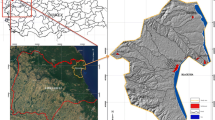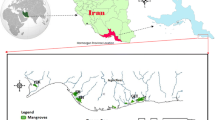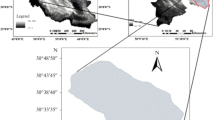Abstract
Mangrove ecosystems play an important functional role in providing coastal protection, carbon sequestration, coastal habitat, climate change resilience and socioeconomic services for coastal communities. The present research study investigates spatiotemporal variation, forest health status and predicts the land cover changes in Sundarban mangrove forests of India using multi-temporal satellite images and cellular automata and Markov Chain model. The results revealed that mangrove forest extent has decreased by 3.14% from 1994 and 2019. The image classification resulted in overall accuracy of 74% in 1994, 81% in 2004, 78% in 2014 and 84.5% in 2019 respectively. The satellite-based vegetation indices were analysed for assessing the health of the forests. The findings of present study indicate deteriorating health of the forest and observed significant vegetation stresses over the western to central part of the study region due to anthropogenic activities. The CA Markov model predicted that the extent of mangrove forests could possibly decline from 2011.60 km2 to 1939.24 km2by the period 2029. The results of the present study could foster better decisions, precise mitigation and sustainable development strategies for the region.
Access this chapter
Tax calculation will be finalised at checkout
Purchases are for personal use only
Similar content being viewed by others
References
Adhikari A, Southworth J (2012) Simulating forest cover changes of Bannerghatta National Park based on a CA–Markov model: a remote sensing approach. Remote Sens 4:3215–3243
Arsanjani JJ, Kainz W, Mousivand AJ (2011) Tracking dynamic land-use change using spatially explicit Markov Chain based on cellular automata: the case of Tehran. Int J Image Data Fusion 2:329–345
Campbell JB, Wynne RH (2011) Introduction to remote sensing. Guilford Press, New York, USA 670 pp. ISBN 978 160918 176 5
Chowdhury A, Maiti SK (2016) Identifying the source and accessing the spatial variations, contamination status, conservation threats of heavy metal pollution in the river waters of Sundarban biosphere reserve. J Coast Conserv India. https://doi.org/10.1007/s11852-016-0436-x
Congalton RG, Green K (2009) Assessing the accuracy of remotely sensed data: principles and practices, 2nd edn. CRC Press, Boca Raton, FL
Croft H, Chen JM, Zhang Y, Simic A, Noland TL, Nesbitt N, Arabian J (2015) Evaluating leaf chlorophyll content prediction from multispectral remote sensing data within a physically-based modelling framework. ISPRS J Photogr Remote Sens 102:85–95
Dasgupta N, Nandy P, Sengupta C, Das S (2018) Genetic variation in relation to adaptability of three mangrove species from the Indian Sundarbans assessed with RAPD and ISSR markers. J Forest Res 29(2):301–310
Etemadi H, Smoak JM, Karami J (2018) Land use change assessment in coastal mangrove forests of Iran utilizing satellite imagery and CA–Markov algorithms to monitor and predict future change. Environ Earth Sci 77(5):208
FAO (2004) Food and agriculture organization (FAO), state of world’s forests 2003. FAO, Rome
Feng Y, Liu Y (2016) Scenario prediction of emerging coastal city using CA modeling under different environmental conditions: a case study of Lingang New City, China. Environ Monit Assess 188:1–15
FSI (2015) India state of forest report. Forest Survey of India. https://fsi.nic.in/isfr-2015/isfr-2015-mangrove-cover.pdf. Accessed date: 13 Mar 2017
Gabler CA, Osland MJ, Grace JB, Stagg CL, Day RH, Hartley SB, Enwright NM, From AS, McCoy ML, McLeod JL (2017) Macroclimatic change expected to transform coastal wetland ecosystems this century. Nat Clim Change 7(2):142
Ghosh A, Schmidt S, Fickert T, Nusser M (2015) The Indian Sundarban mangrove forests: history, utilization, conservation strategies and local perception. Diversity 7(2):149–169
Ghosh P, Mukhopadhyay A, Chanda A, Mondal P, Akhand A, Mukherjee S, Nayak SK, Ghosh S, Mitra D, Ghosh T, Hazra S (2017) Application of cellular automata and Markov-chain model in geospatial environmental modeling—a review. Remote Sens Appl Soc Environ 5:64–77
Giri C, Ochieng E, Tieszen LL, Zhu Z, Singh A, Loveland T, Masek J, Duke N (2011) Status and distribution of mangrove forests of the world using earth observation satellite data. Glob Ecol Biogeogr 20:154–159
Heumann BW (2011) Satellite remote sensing of mangrove forests: recent advances and future opportunities. Prog Phys Geog 35:87–108
Jordan CF (1969) Derivation of leaf area index from quality of light on the forest floor. Ecology 50:663–666
Keshtkar H, Voigt W (2016) A spatiotemporal analysis of landscape change using an integrated Markov chain and cellular automata models. Model Earth Syst Environ 2(1):10
Mafi-Gholami D, Zenner EK, Jaafari A (2020) Mangrove regional feedback to sea level rise and drought intensity at the end of the 21st century. Ecol Ind 110:105972
Mas JF, Kolb M, Paegelow M, Olmedo MTC, Houet T (2014) Inductive pattern-based land use/cover change models: a comparison of four software packages. Environ Modell Softw 51:94–111
Mukhopadhyay A, Mondal P, Barik J, Chowdhury SM, Ghosh T, Hazra S (2015) Changes in mangrove species assemblages and future prediction of the Bangladesh Sundarbans using Markov chain model and cellular automata. Environ Sci Process Impacts 17(6):1111–1117
Pan Y et al (2011) A large and persistent carbon sink in the world’s forests. Science 333:988–993
Perera KARS, De Silva KHWL, Amarasinghe MD (2018) Potential impact of predicted sea level rise on carbon sink function of mangrove ecosystems with special reference to Negombo estuary, Sri Lanka. Glob Planet Change 161:162–171
Piao S et al (2015) Detection and attribution of vegetation greening trend in China over the last 30 years. Glob Change Biol 21(4):1601–1609
Rahman MR, Hossain MB (2015) Changes in land use pattern at Chakaria Sundarbans mangrove forest in Bangladesh. Bangladesh Res Public J 11(1):13–20
Rahman AF, Dragoni D, Didan K, Barreto-Munoz A, Hutabarat JA (2013) Detecting large scale conversion of mangroves to aquaculture with change point and mixed pixel analyses of high-fidelity MODIS data. Remote Sens Environ 130:96–107
Roujean JL, Breon FM (1995) Estimating PAR absorbed by vegetation from bidirectional reflectance measurements. Remote Sens Environ 51:375–384
Roy PS, Sharma KP, Jain A (1996) Stratification of density in dry deciduous forest using satellite remote sensing digital data—an approach based on spectral indices. J Biosci 21(5):723–734
Sanders CJ, Smoak JM, Naidu AS, Sanders LM, Patchineelam SR (2010) Organic carbon burial in a mangrove forest, margin and intertidal mud flat. Estuar Coast Shelf Sci 90(3):168–172
Sandilyan S, Kathiresan K (2015) Density of waterbirds in relation to habitats of Pichavaram mangroves. Southern India J Coast Conserv 19(2):131–139
Sivakumar K (2013) Coastal and marine biodiversity protected Areas in India. In: Venkataraman K, Sivaperuman C, Raghunathan C (eds) Ecology and conservation of tropical marine faunal communities. Springer Heidelberg, New York, pp. 463–476. ISBN 978-3-642-38200-0
Tanner MK, Moity N, Costa MT, Jarrin JRM, Aburto-Oropeza O, Salinas-de-León P (2019) Mangroves in the galapagos: ecosystem services and their valuation. Ecol Econ 160:12–24
Yang J, Gong P, Fu R, Zhang M, Chen J, Liang S et al (2013) The role of satellite remote sensing in climate change studies. Nat Clim Change 3:875–883
Yang X, Zheng X-Q, Lv LN (2012) A spatiotemporal model of land use change based on ant colony optimization, Markov chain and cellular automata. Ecol Model 233:11–19
Zubair H (2019) Prediction of land use and land cover (LULC) changes using CA Markov model in Mamuju Subdistrict. J Phys Conf Ser 1341(8):082033 (IOP Publishing)
Author information
Authors and Affiliations
Corresponding author
Editor information
Editors and Affiliations
Rights and permissions
Copyright information
© 2021 The Editor(s) (if applicable) and The Author(s), under exclusive license to Springer Nature Switzerland AG
About this chapter
Cite this chapter
Halder, S., Samanta, K., Das, S. (2021). Monitoring and Prediction of Dynamics in Sundarban Forest using CA–Markov Chain Model. In: Shit, P.K., Pourghasemi, H.R., Das, P., Bhunia, G.S. (eds) Spatial Modeling in Forest Resources Management . Environmental Science and Engineering. Springer, Cham. https://doi.org/10.1007/978-3-030-56542-8_18
Download citation
DOI: https://doi.org/10.1007/978-3-030-56542-8_18
Published:
Publisher Name: Springer, Cham
Print ISBN: 978-3-030-56541-1
Online ISBN: 978-3-030-56542-8
eBook Packages: Earth and Environmental ScienceEarth and Environmental Science (R0)




